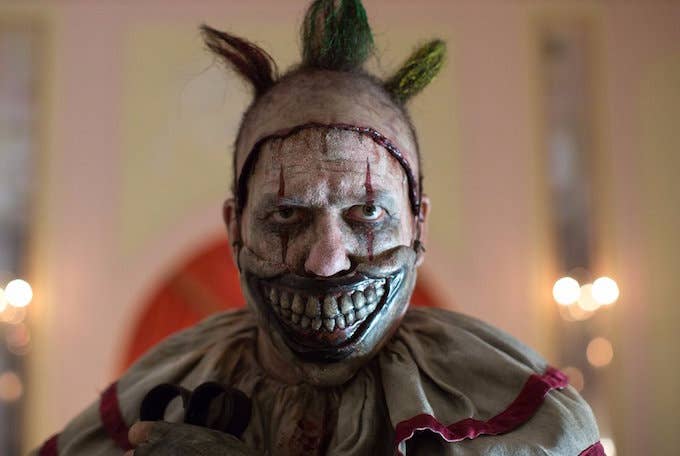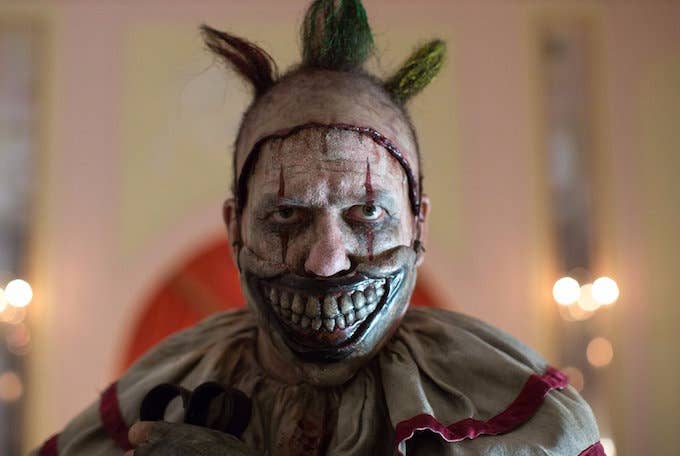
Joseph Grimaldi was the star of the Regency era-theater circuit in London; a by-all-accounts inventive performer who rewrote the rule book that said the klutzy pantomime must be the secondary character and became an early example of the sidekick usurping the lead to be the one the crowds want to see.
Those were much more innocent times.
In the 180 years since Grimaldi’s death, his beloved clown persona has been squirted with a can of John Wayne Gacy seltzer, hit with a deck of Jokers and drifted off like a hypnotizing red balloon to unfold as the creations we have for 2017: abducting, haunting, smirking monsters unlikely to receive many five-star reviews if they were so inclined to advertise their birthday party businesses on Yelp.
Earning center stage in this big tent is Bill Skarsgard’s Pennywise. The shape-shifting star in this fall’s remake of author Stephen King’s It didn’t waste any time hiding his homicidal appetite from viewers; killing a kid in the film’s opening scene. But he’s got a hearty backup act thanks to American Horror Story: Cult. Teased in the previews for the latest installment of FX’s horror anthology and growing out of John Carroll Lynch’s Twisty from AHS: Freak Show, this pack of blood-thirsty Bozos have adults on the run.
Even BoJack Horseman, the Netflix animated series about a washed-up sitcom star who happens to be a talking horse, had a B plot this season revolving around Aaron Paul’s credulous Todd and his accidental creation of a society of rabies-infected clown dentists. (They live in the woods near an abandoned insane asylum, naturally).
“Sometimes, cultural fears can manifest in strange and unexpected ways,” says Phil Simpson, a professed horror buff and the president of academic organization, Popular Culture Association & American Culture Association.
To be fair, modern society has not exactly been endearing to the clowning lifestyle. Earlier this year, Insane Clown Posse fans (aka Juggalos) marched on Washington to protest being classified as a gang by the FBI—many showing solidarity through white and black face paint. Some weeks prior to that, Ringling Bros. Circus closed and put many professional clowns (among others) out of work. Even fictitious fast food mascot Ronald McDonald can’t catch a break. McDonald’s upgraded the iconic character’s clown costume in 2014, but the stigma associated with his profession was still strong enough for the Los Angeles Times to inquire “Is he still creepy? Just ask yourself if you’d let him date your daughter.” Also not helping their cause: the bizarre and unexplainable sightings of people dressed in traditional clowning garb popped up around the globe in the lead-up to last year’s presidential election.
“Between the fact that (this year’s) It adaptation was very much in the forefront of the cultural consciousness and you have a time of great polarization in the country itself during the election cycle, I think the two just kind of converged,” Simpson theorizes.
Indeed, there have been hints of this trend coming if you knew where to look (or, if perhaps, you happen to be an entertainment journalist who has gotten herself stuck in a paranoid rabbit hole of her own design after spending a couple weeks researching this). NBC’s The Good Place went through a sort-of reinvention for its second season. But you know what did stay? Those vivid clown paintings that decorate Eleanor Shellstrop’s (Kristen Bell) house-prison. And Jerome Valeska (Cameron Monaghan)—the diabolical bag of tricks whom fans have long thought to have a correlation to infamous Batman nemesis, the Joker—just won’t stay dead on Fox’s Gotham.
Or, are we as a society are stuck in our own warped form of a Kübler-Ross hierarchy? Last year, Vulture journalist Kyle Buchanan took a cue from the weapon of choice preferred by Suicide Squad’s Harley Quinn (Margot Robbie), The Walking Dead’s Negan (Jeffrey Dean Morgan) and—of course—Beyonce to declare 2016 the year of the baseball bat.
“When you swing that bat, it’s surely gonna be brutal, and to even wield one is proof that you’re ready to go beyond the pale,” Buchanan wrote then, comparing the skull-cracking accuracy a Louisville Slugger affords to the ample missed opportunities that result when using Hollywood former favorite murderous agent, the bow and arrow.
Since that essay was published, we’ve seen environmental and social destruction of Old Testament proportions. So should we, collectively, be scared now that we’ve both physically and metaphorically smashed our surroundings to bits? Should we be doubling back to find that even the most innocuous images from our childhood can now produce adrenaline rushes?
“In a lot of ways, the anxiety of fear or fright manifests itself in anger,” Simpson says. “People, when they’re scared or anxious, they feel helpless; they feel trapped; they feel vulnerable. And a natural reaction to that, in many instances, is anger or even hatred. And we certainly see a lot of that in our polarized country.”
Norma Jones, the editor of academic publication, The Popular Culture Studies Journal, argues that this trend could be a natural progression from another media genre that’s garnered so much attention over the years.
“We have so many superhero movies right now,” she says, explaining that these films are “safe”—both for box office sales and because of the way they make audiences feel. Whereas, she says shows like American Horror Story or even The Walking Dead, “let us explore the idea of what if everything’s not so great because there are a lot of scary things happening around the world that we’re privy to … [these shows] allow us to really think about some of the really scary things that are happening in our lives and maybe deal with it in a way that’s more rational and creatively than jumping off a building.”
This is the point in this article where I’m required to mention President Trump because this is an article written in 2017. In this case, it’s to remind that—the many memes of him in face paint aside—he is not to blame for all of Hollywood’s attempt to send the nation into a permanent state of coulrophobia. Yes, the first episode of this season of Horror Story was called “Election Night” and anthology co-creator Ryan Murphy has been quite public about the event’s influence on this chapter of the show. But It’s been in production for years and BoJack creator Raphael Bob-Waksberg has stated that this idea has also long been percolating in his mind.
Simpson says this comparison is a “symptom of a larger cultural malaise” and Jones adds that our obsessive need to “internalize” everything is actually what she likes best about pop culture.
“It is all about how we internalize these texts and creations and what we make of them,” she says. “That’s what’s so important about popular culture; it’s not stuck to one side or the other. It can actually fulfill both needs of multiple parties.”
Luckily for Jones and other pop culture analytics fans, there’s plenty of time to ponder this trend’s ramifications because another It movie will premiere in September 2019.

